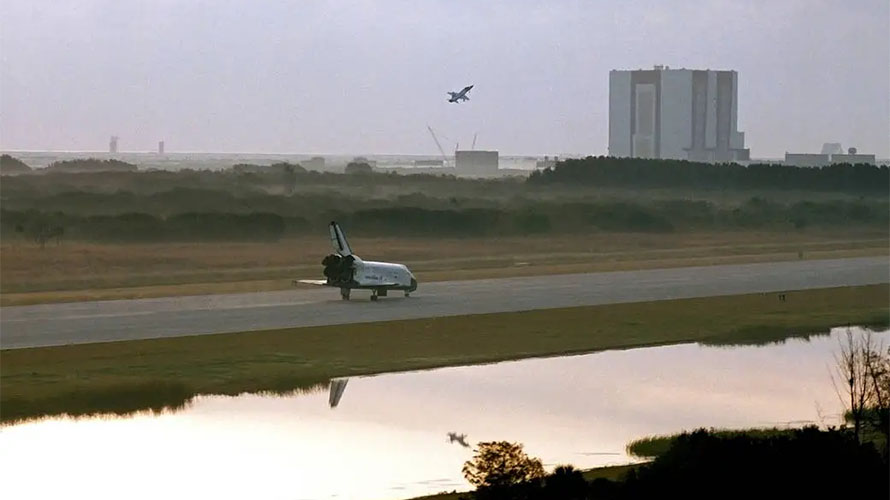Photo: Gibson’s first shuttle mission was the first to land at Kennedy Space Center. Credit: NASA
By Robin Scott
Robert “Hoot” Gibson is not only a great NASA astronaut, he is also a great storyteller. On January 8 he provided the Iowa Chapter with unique insights from his outstanding career both as a Navy pilot and space shuttle astronaut.
His talk to the Iowa Chapter can be seen online at https://www.youtube.com/watch?v=XQly6A_nDcQ.
Gibson’s mom and dad both flew planes, providing him with an inspiring environment. He achieved his childhood dream to be like his dad, who was an aeronautical engineer and test pilot.
After getting an aeronautical engineering degree and training as a Navy pilot, he experienced the excitement of flying an F-4 Phantom off of an aircraft carrier and then accurately landing within the carrier’s limited space. In 1972, Gibson’s squadron sent him to Navy Fighter Weapons “Top Gun” School where he flew the F-14 Tomcat jet fighter, which had a top speed of Mach 2.34, a variable-sweep wing, and 20% better overall capabilities than the F-4 Phantom that it replaced. After three cruises flying Tomcats, Gibson was selected for Navy test pilot school, which was one big accomplishment that qualified him to be selected as one of the first class of 35 space shuttle astronauts in 1978.
For his first six years as an astronaut, he worked in the software verification laboratory, as the deputy chief of aircraft operations for NASA, and as a T-38 chase plane pilot for the first two shuttle launches. For training, a T-38 chase plane and SR-71 Blackbird (Mach 3) were used to simulate the space shuttle landings. Gibson’s chase plane crew supported early launches by being prepared for return to launch site abort at lift off, ready to intercept the shuttle and follow it to touch down to check landing gear, give a cross check on altitude and speed, and call main gear and nose gear touch down heights.
Gibson flew five space shuttle missions. He was co-pilot on his first shuttle mission (Challenger, February 3–11, 1984), which deployed two commercial satellites, made the first landing at Cape Canaveral, and the first untethered space walks using a rocket pack with a translation and attitude controller. Landing at Cape Canaveral saved the expense of transport from and risk of weather exposure on a 747 flight from California.
Gibson was the Mission Commander on his second shuttle flight (Columbia, January 12–18, 1986), which deployed one satellite, did science experiments, pointed two ultraviolet telescopes, and was the second shuttle night landing. He had trained at night prior to this mission. His seven-member crew included House Subcommittee Chairman Bill Nelson, who was invited by NASA. Ten days after their landing, Challenger exploded. Gibson supported the investigation of the Challenger explosion and worked on the redesign and recertification of the rocket boosters.
Gibson was Mission Commander of his third flight (Atlantis, December 2–6,1988), which carried Department of Defense and other payloads. He trained a year for this mission.
Gibson was Mission Commander for his fourth flight (Endeavor, September 12–20, 1992), which was funded by Japan. The crew performed 40 material and life science experiments and built the largest single indium antimonide crystal. The crew was divided to do alternate 12-hour shifts and used foot loops to keep them in place so they could use both hands.
With the most experience after four missions, he was appointed by NASA to be the Chief Astronaut; but then NASA asked him to be Mission Commander of their very first shuttle docking mission with the Russian Space Station Mir (Atlantis, June 27 to July 7, 1995). The U.S. and Russian crew trained in Russia for 1.5 years and had done 100-docking simulations. Gibson successfully aligned the centers of two 4-foot docking rings to within three inches; and the mission featured crew changes, experiments, and transfer items to and from Atlantis. Space shuttle missions ended in 2011.
Gibson said his biggest thrill of going to space was the view of the Earth. He offered example pictures of Earth including Greenland, air traffic contrails, the Nile River, pyramids, and air glow; but the Northern and Southern lights were the prettiest.



















